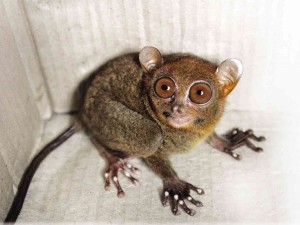
The Philippine tarsier (Tarsius syrichta) is one of the smallest known primates in the world.
No larger than an adult person’s hand, its size ranges from 118 to 149 millimeters (4.6 to 5.8 inches) while its average weight is between 113 to 142 grams (about 1/10 of a kilo).
In 1986, the Philippine tarsier was listed as “endangered” by the International Union for Conservation of Nature (IUCN) Conservation Monitoring Center. A check with the IUCN Red List of Threatened Species currently lists it as “near threatened.”
A number of legislation has been passed to protect and conserve the Philippine tarsier, among them the Department of Environment and Natural Resources’ Administrative Order No. 48, which included it as a protected species among other endangered animals.
Endemic to the Philippines, tarsiers are nocturnal creatures that live on a diet of small lizards, frogs and insects. They have thin, rough fur, whose color ranges from gray to dark brown. Tarsiers communicate with each other using loud piercing notes.
The Philippine tarsier is believed to have been around for 45 million years, making it one of the oldest land species existing in the country.
A tarsier that lives in the wild can survive up to more than 20 years while a tarsier in captivity lives usually for 12 years.
Philippine tarsiers are found mostly in Samar, Leyte, Bohol and in some parts of Mindanao. Inquirer Research
(Sources: denr.gov.ph, gov.ph, iucnredlist.org, Inquirer Archives)